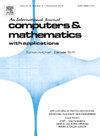Novel connection of spectral scheme and one-step of s-order approaches for MHD flows enclosed a duct
IF 2.9
2区 数学
Q1 MATHEMATICS, APPLIED
引用次数: 0
Abstract
A challenging and common problem that frequently arises in the fields of physics and engineering, two-dimensional (2D) incompressible, viscous MHD duct flows have significant theoretical and practical significance due to their numerous and widespread applications in astrophysics, geology, power generation, MHD generators, electromagnetic pumps, accelerators, blood flow measurements, drug delivery, and other areas. Therefore, a robust solution to such a problem becomes a challenging task for the research community. This framework develops a novel connection to inspect the accurate and rapid convergent solutions of a coupled system of convection-diffusion equations arising in 2D unsteady MHD flows. This coupling is based on one-step s-stage/order methods to approximate the temporal variable with the Vieta-Fibonacci polynomials-based spectral method to estimate the spatial variables. The spatial derivative terms given in the problem under discussion are replaced by new operational matrices of integer order. The paper incorporates related theorems to provide a mathematical validation of the techniques. Additionally, we conduct a study on convergence and error bonds to verify the computational algorithm's mathematical formulation. A thorough comparison analysis illustrates the validity, correctness, and dependability of the computational approach that is now recommended. Novel investigation includes the spectral technique coupled with the fourth-order Runge-Kutta method handles the nonlinear issue very well to investigate the exact smooth solutions to physical problems. The suggested schemes are discovered to have an exponential order of convergence in the spatial direction, and the COC in the temporal direction confirms the findings of previous research.
封闭管道的 MHD 流动的光谱方案与 s 阶一步法之间的新联系
二维不可压缩粘性MHD管道流动是物理和工程领域中经常出现的一个具有挑战性和普遍性的问题,它在天体物理、地质、发电、MHD发生器、电磁泵、加速器、血流测量、药物输送等领域有着广泛的应用,具有重要的理论和现实意义。因此,对这一问题的可靠解决方案成为研究界的一项具有挑战性的任务。该框架开发了一种新的连接,用于检查二维非定常MHD流动中出现的对流-扩散方程耦合系统的精确和快速收敛解。这种耦合基于一步s阶段/顺序方法来近似时间变量,基于Vieta-Fibonacci多项式的光谱方法来估计空间变量。讨论问题中给出的空间导数项被新的整数阶运算矩阵所取代。本文结合了相关定理,对这些技术进行了数学验证。此外,我们还进行了收敛性和误差键的研究,以验证计算算法的数学公式。全面的比较分析说明了现在推荐的计算方法的有效性、正确性和可靠性。新的研究包括光谱技术与四阶龙格-库塔方法相结合,很好地处理了非线性问题,以研究物理问题的精确光滑解。所提出的方案在空间方向上具有指数级的收敛性,而在时间方向上的COC证实了前人的研究结果。
本文章由计算机程序翻译,如有差异,请以英文原文为准。
求助全文
约1分钟内获得全文
求助全文
来源期刊

Computers & Mathematics with Applications
工程技术-计算机:跨学科应用
CiteScore
5.10
自引率
10.30%
发文量
396
审稿时长
9.9 weeks
期刊介绍:
Computers & Mathematics with Applications provides a medium of exchange for those engaged in fields contributing to building successful simulations for science and engineering using Partial Differential Equations (PDEs).
 求助内容:
求助内容: 应助结果提醒方式:
应助结果提醒方式:


